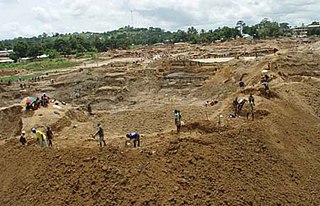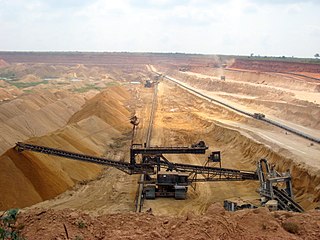
Sierra Leone, officially the Republic of Sierra Leone, is a country on the southwest coast of West Africa. It shares its southeastern border with Liberia, and the northern half of the nation is surrounded by Guinea. Covering a total area of 71,740 km2 (27,699 sq mi), Sierra Leone has a tropical climate, with diverse environments ranging from savanna to rainforests. The country has a population of 7,092,113 as of the 2015 census. Freetown is the capital and largest city. The country is divided into five administrative regions, which are subdivided into 16 districts.

The economy of Sierra Leone is $4.082 billion by gross domestic product as of 2018. Since the end of the Sierra Leone Civil War in 2002, the economy is gradually recovering with a gross domestic product growth rate between 4 and 7%. In 2008 it in PPP ranked between 147th by World Bank, and 153rd by CIA, largest in the world.
Telecommunications in Sierra Leone include radio, television, fixed and mobile telephones, and the Internet.

There are a number of systems of transport in Sierra Leone, a country in West Africa, which possess road, rail, air and water infrastructure, including a network of highways and several airports.

Koidu Town is the capital and largest city of the diamond-rich Kono District in the Eastern Province of Sierra Leone. The population of Koidu Town is 124,662 based on the 2015 Sierra Leone national census. Koidu Town is the fifth largest city in Sierra Leone by population, after Freetown, Kenema, Bo and Makeni. Koidu Town is a major urban, business, commercial and diamond trade center. Koidu Town lies approximately 280 miles east of Freetown, and about 60 miles north of Kenema.
Sierra Leone FA Cup, commonly known as the FA Cup, is the national knockout cup competition in Sierra Leone. It was established in 1967. The competition is run by the Sierra Leone Football Association. Cup winners qualify for the CAF Confederation Cup.

Mass media in Sierra Leone began when the first modern printing press in Africa arrived at the start of the 19th century. In the 1860s the country became a journalist hub for Africa with professional travelling to the country from across the continent. At the end of the 19th century the industry went into decline and when radio was introduced in the 1930s this became the primary communication media. Print media is not widely read in Sierra Leone, especially outside Freetown, partially due to the low levels of literacy in the country. In 2008 there were 15 daily newspapers in addition to those published weekly. Among newspaper readership young people are likely to read newspapers weekly and older people daily. The majority of newspapers are privately run and are often critical of the government.
Tongo, also known as Tongoma, is a diamond mining town and the second largest city in Kenema District, located in the Eastern Province of Sierra Leone. Tongo is about twenty seven miles to Kenema. The population of the 60-sq.-mile city is 44,376.

The Sierra Leone Police (SLP) is the national police force of the Republic of Sierra Leone. It is primarily responsible for law enforcement and crime investigation throughout Sierra Leone. The Sierra Leone Police is under the jurisdiction of the Sierra Leone Ministry of Internal Affairs, a cabinet ministry in the Government of Sierra Leone.

The Mining industry of Ghana accounts for 5% of the country's GDP and minerals make up 37% of total exports. Gold contributes over 90% of the total mineral exports. Thus, the main focus of Ghana's mining and minerals development industry remains focused on gold. Ghana is Africa's largest gold producer, producing 80.5 t in 2008. Ghana is also a major producer of bauxite, manganese and diamonds. Ghana has 20 large-scale mining companies producing gold, diamonds, bauxite and manganese; over 300 registered small scale mining groups; and 90 mine support service companies.Other mineral commodities produced in the country are natural gas, petroleum, salt, and silver.
The Sierra Leone Broadcasting Corporation (SLBC) is the national radio and television broadcaster in Sierra Leone. It is owned by the government of Sierra Leone and is a branch of the Sierra Leone Ministry of Information and Communications. It is theoretically regulated by the Independent Media Commission (IMC). The SLBC primarily broadcasts the national television and regional radio service from its headquarters in the New England neighborhood of Freetown. Regional stations provide FM radio services in Bo, Kenema, Kailahun, Makeni, Magburaka and Koidu.

There are 84 kilometres of railway in Sierra Leone, all of which is private and of a narrow gauge, 1,067 mm.
The Mines and Steel Development Ministry is a Nigerian ministry established in 1985 to encourage development of the country's solid mineral resources. The Ministry formulates policy, provides information on mining potential and production, regulates operations and generates revenue for the government. Operational departments include Mining cadastre , Geological survey of Nigeria, Mines inspectorate, Artisanal and small-scale mining and Mining environment.

The mining industry of Sierra Leone accounted for 4.5 percent of the country's GDP in 2007 and minerals made up 79 percent of total export revenue with diamonds accounting for 46 percent of export revenue in 2008. The main minerals mined in Sierra Leone are diamonds, rutile, bauxite, gold, iron and limonite.
Alhaji Alpha Sahid Bakar Kanu is a Sierra Leonean politician and the current Sierra Leone minister of Presidential and Public Affairs. He is also the official spokesman of the All People's Congress (APC) political party, a position he has held even before the APC came to power. In January 2012, Kanu was chosen by Sierra Leone president Ernest Bai Koroma to serve as Minister of Information and Communication in Koroma's new second term cabinet.

Water supply in Sierra Leone is characterized by limited access to safe drinking water. Despite efforts by the government and numerous non-governmental organizations, access has not much improved since the end of the Sierra Leone Civil War in 2002, stagnating at about 50% and even declining in rural areas. In the capital Freetown, taps often run dry. It is hoped that a new dam in Orugu, for which China committed financing in 2009, will alleviate water scarcity.

Alhaji Usman Boie Kamara is a Sierra Leonean politician, businessman and mining engineer who has been Minister of Trade and Industry of Sierra Leone since 2013. He previously worked as director of the Sierra Leone National Diamond Mining Company (NDMC).

The mining industry of Togo is centred mainly around the extraction of phosphate, ranking it 19th in world production. Other minerals extracted are diamond, gold, and limestone. More minerals identified but yet to be brought into production mode are manganese, bauxite, gypsum, iron ore, marble, rutile, and zinc. The mineral sector contributes 2.8% to the country's gross domestic product (GDP).

The mining industry of Liberia has witnessed a revival after the civil war which ended in 2003. Gold, diamonds, and iron ore form the core minerals of the mining sector with a new Mineral Development Policy and Mining Code being put in place to attract foreign investments. In 2013, the mineral sector accounted for 11% of GDP in the country and the World Bank projected a further increase in the sector by 2017.
The geology of Liberia is largely extremely ancient rock formed between 3.5 billion and 539 million years ago in the Archean and the Neoproterozoic, with some rocks from the past 145 million years near the coast. The country has rich iron resources as well as some diamonds, gold and other minerals in ancient sediment formations weathered to higher concentrations by tropical rainfall.












